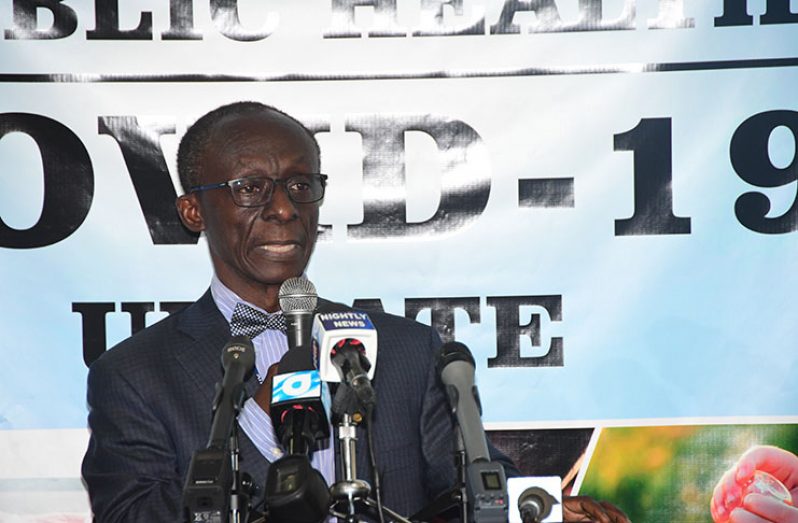– PAHO Representative, points to drop in projected cases
– warns that early removal of measures could be detrimental
By Navendra Seoraj
GUYANA is on course to “flattening the curve” and reducing the spread of the Novel Coronavirus (COVID-19) disease, said Resident Pan American Health Organisation/World Health Organisation (PAHO/WHO) Representative, Dr. William Adu-Krow, who noted that this will only remain possible if government maintains the existing containment measures.
Locally, there are more than 60 cases of COVID-19, with six deaths. And, with no approved treatment or cure, there is no assurance that persons will survive after contracting the disease. In the absence of approved medication, governments and authorities across the world have employed a number of preventative measures to contain the spread of the disease.
Locally, the government had extended its emergency measures to combat the dreaded disease, with the imposition of a 12-hour curfew on citizens. These emergency measures were taken pursuant to paragraphs (1) and (2) (b) of the directions issued by the President, in accordance with the Public Health Ordinance, Cap. 145, and published in the Official Gazette, Legal Supplement B on March 16 2020.
The measures at reference took effect from April 3, 2020, and will last one month, unless earlier terminated, extended or amended by notice of the Minister of Public Health, after an assessment of the prevailing public health conditions.
“The measures in place are working and individual measures are working too, but we need to ensure that government enforces the existing measures…the few persons who do not go by these measures, need to comply…we need to see more improvement,” said Dr. Adu-Krow during a virtual press briefing, on Friday.
Already, there have been revised projections which show a reduction in the probable cases, but Dr. Adu-Krow said the new projections can only be maintained if the measures are maintained.
The Ministry of Public Health, using the PAHO/WHO method, had initially projected 1,400 cases, but a study done by PAHO/WHO found that with every case, another 2.5 persons will be affected within five days if there is no partial lockdown and if persons do not exercise effective social distancing.
“That 2.5, if I infect you, you infect 2.5 others and they infect another 2.5. Within a month we will get over 20,000; it is a simple model but it makes a lot of sense,” said Resident PAHO/WHO Representative, Dr. William Adu-Krow, in a News Room report.
Dr. Adu-Krow had said if this should happen, five per cent or 1000 of those infected, would need intensive care and Guyana simply does not have the capacity for this.
This study was, however, done prior to government’s implementation of additional measures, including a curfew.
On Friday, Dr. Adu-Krow, with the use of graphs, showed journalists how the projected cases moved from reaching 20,000 in a month to just under 1,000 in a month, with the implementation of the containment measures. If these measures were to, however, be relaxed Guyana could see about 5,000 cases in no time.
Additionally, the past projection of one person infecting 2.5 persons was also revised to one person infecting about 1.5 persons.
“Because of the curfew and other measures we are seeing a drop in the projections…we were seeing a bad curve, but these measures have contributed to a drop in the number of cases,” said Dr. Adu-Krow.
The revised projections are also credited to the work of healthcare workers, who, according to Dr. Adu-Krow, have played their role in ensuring that Guyana does not get to the initial 20,000 projected cases.
In a breakdown of how Guyana managed to dodge the initial projections, Dr. Adu-Krow said Guyana was projected to have 12 cases on April 1 but had 19; 21 on April 3 but had 22; and post-curfew, the country was projected to have 32 cases by April 5, but had 23; 50 by April 7 but had 35; 81 by April 8 but had 37; 142 by April 11 but had 45; 190 by April 19 but had 47 and 295 by April 15 but had 55.
“By the fact that 240 persons were prevented from being infected, we saved 25.2 lives,” said Dr. Adu-Krow.
These results are mainly because of the measures in place, but Dr. Adu-Krow believes that there could easily be a retrogression if the curfew and other measures are lifted. WHO has outlined six criteria for governments to meet before lifting measures and this includes having a healthcare system that could deal with any case that may appear.
MIDDLE GROUND
“My advice to government is that we do not think about removing measures too soon and we should not think about removing measures too quickly…we are now fighting for people’s lives and livelihoods…we need to find a middle ground,” he said.
He said society must work collectively towards finding a middle point between saving lives and livelihoods, and determining when the right time for lifting the measures is.
As Guyana continues to battle the pandemic, he encouraged persons to adhere to the measures and continue practising social and physical distancing.
According to WHO, COVID-19 is an infectious disease caused by the newly discovered coronavirus.
WHO said most people infected with the COVID-19 virus will experience mild to moderate respiratory illnesses and recover without requiring special treatment. Older persons and those with underlying medical problems such as cardiovascular disease, diabetes, chronic respiratory disease, and cancer, are more likely to develop serious illness.
The WHO believes that the best way to prevent and slow down transmission is to be well informed about the virus, the disease it causes and how it is spread.
“Protect yourself and others from infection by washing your hands or using an alcohol-based rub frequently and not touching your face. The COVID-19 virus spreads primarily through droplets of saliva or discharge from the nose when an infected person coughs or sneezes, so it’s important that you also practise respiratory etiquette (for example, by coughing into a flexed elbow),” the WHO has advised.



.jpg)









